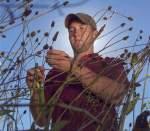Growing Opportunity: Research team develops trademarked line of native seeds, plants

There is a rule of thumb among native plant growers: The first year, it sleeps. The second, it creeps. And the third year, it leaps. Reintroducing native varieties takes time, but the effort pays off handsomely. Once these long-lived plants are established, they're essentially maintenance free. They don't require fertilizer, because they're adapted to native soils. And they don't require pesticides, because they're adapted to native insects. They're almost impervious to drought and can even survive fire.
Some researchers at the University of Louisiana at Lafayette's Ecology Center have been working to preserve and propagate native plants since 2007. This year: they launched a commercial initiative: PureNativeTM seed mixes, specialized blends of seeds from plants that are native to south Louisiana. The center sells PureNativeTM plants and intends to create seven seed mixtures:
Wetlands Habitat; Wildlife Support; Rancher's Grasses; Pollinator Attraction - Urban; Pollinator Attraction - Agriculture; Urban Landscaping - Color; and Urban Landscaping - Pond.
![]()
Seeds pictured above: Little Bluestem, Texas Coneflower, Lanceleaf Blanketflower, Eastern Gama Grass, Longspike Tridens, Indian Grass, and False Aloe.
"We've not only been collecting seeds and growing plants, we've been studying the properties of individual species," said Andre Daugereaux, manager of the Ecology Center. Grasses are especially appealing to farmers and ranchers because they require little or no maintenance and provide nutritious grazing food for livestock. Native plants can reduce erosion and improve soil and water quality. Some of the plants are attractive to insects and birds that pollinate crops. Native plants are used in restoration projects or along highways. Hunters use the plants to create habitat, especially for birds. And some varieties, including grasses and flowers, are used in ornamental landscaping.
Dr. Susan Mopper, a University biology professor and director of the Center, said the plants are a valuable resource. "Agriculture and development, over a long period of time, have significantly diminished native habitat," she said. Acadiana lies at the edge of the Gulf Coast prairie, which extends into Texas. Tallgrass prairie once covered more than nine million acres; less than 0.1 percent remains. In Louisiana, only about 200 acres are left, mostly in remnants found on narrow strips of land along railroad tracks. The former rights-of-way were never converted to farmland, so native plants still grow there. Some private landowners allow researchers and volunteers to collect seeds on those patches of prairie.
Larry Allain is a botanist at the National Wetlands Research Center and an expert on native plants. He's also a UL Lafayette alumnus who has helped to establish several prairie restorations sites in Acadiana, collected seed on prairie remnants and established plantings at the Ecology Center. "Even though we've put some effort into re-creating these patches of prairie, it seems we can't compete with Mother Nature when it comes to diversity These prairie restorations are just a facsimile of the real thing. They don't seem to function like native prairie," he said. they're in Kansas. On a remnant, there may be as many as 30 species growing together. On a re-created prairie, only two or three may thrive. "We don't yet understand how nature can pack so many different plants into a small area," he explained. These native plants' growing habits make it challenging to harvest seed. Commercial crops are planted as single crops, in rows, so they can be harvested with specialized equipment. But the prairie plants are part of an ecosystem, with dozens of intertwined varieties that mature and bloom at different times. So seed must be collected by hand. "There's a lot we still don't know about these plants. For example, we know they're long-lived, but how long do they live? We don't know for sure," Allain said. Big bluestem is a prairie grass with blue-green stems that can grow as tall as 10 feet. "A single plant may live for hundreds, or perhaps thousands of years. "In this way, they are similar to trees, but they have a different strategy for survival. While trees store energy above ground, these plants store energy below ground, in their roots." Native plants form a network of roots in the Louisiana prairie's shallow topsoil. There's a layer of hard clay about 10 inches below the surface. "You might ask, 'How can you have a prairie in Louisiana?' Prairies are dry places. In the Midwest, you get maybe 20 to 30 inches of rain per year. Here, we get 60. "But because the layer of topsoil is so shallow, when we go three weeks without rain, the soil dries out, and these plants think They hunker down." Louisiana experienced one of its worst droughts in 2011. "The pasture grass died. It was crisp and brown. But these natives were still green. They were doing just fine," Allain said. About 500 native species have been identified. The Ecology Center is studying about 40 plants. The Center, which occupies about 50 acres near Carencro, La., devotes about six acres to native plants, including a wetland. Staff members collect seeds from prairie remnants as well as plants grown on site. Some of the seeds are used to grow seedlings in the Center's large greenhouses. Those seedlings are transplanted in the Center's fields, or sold. At harvest time, seeds are collected, cleaned and stored in a massive freezer large enough to accommodate an 18-wheeler. (The Center's main building was originally a food processing center.) "The Ecology Center is an ideal place to continue this work," said Allain. "The facility has everything necessary to carry out the research. And the Center has a history of working within restoration guidelines to successfully establish plants."
